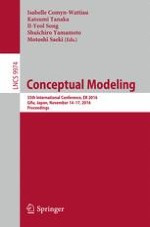This book constitutes the refereed proceedings of the 345h International Conference on Conceptual Modeling, ER 2016, held in Gifu, Japan, in November 2016.
The 23 full and 18 short papers presented together with 3 keynotes were carefully reviewed and selected from 113 submissions. The papers are organized in topical sections on Analytics and Conceptual Modeling; Conceptual Modeling and Ontologies; Requirements Engineering; Advanced Conceptual Modeling; Semantic Annotations; Modeling and Executing Business Processes; Business Process Management and Modeling; Applications and Experiments of Conceptual Modeling; Schema Mapping; Conceptual Modeling Guidance; and Goal Modeling.
